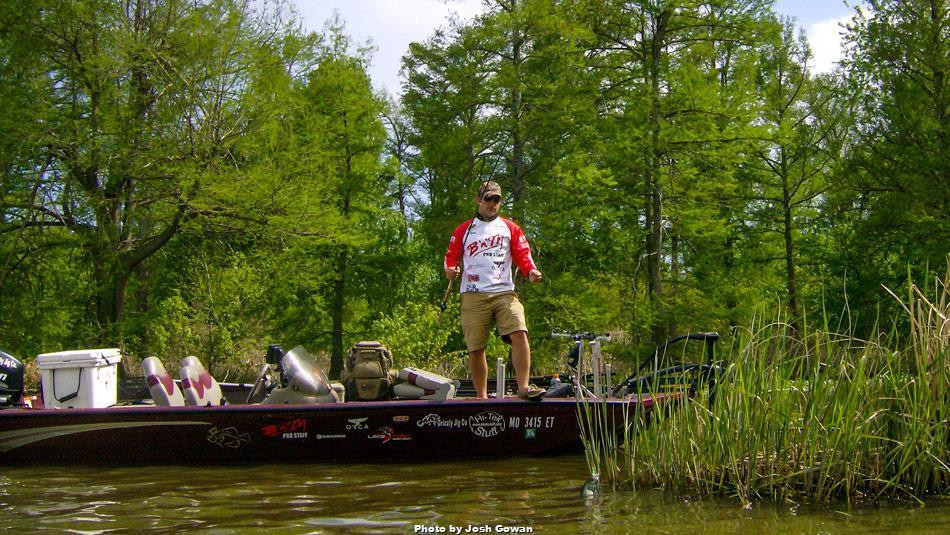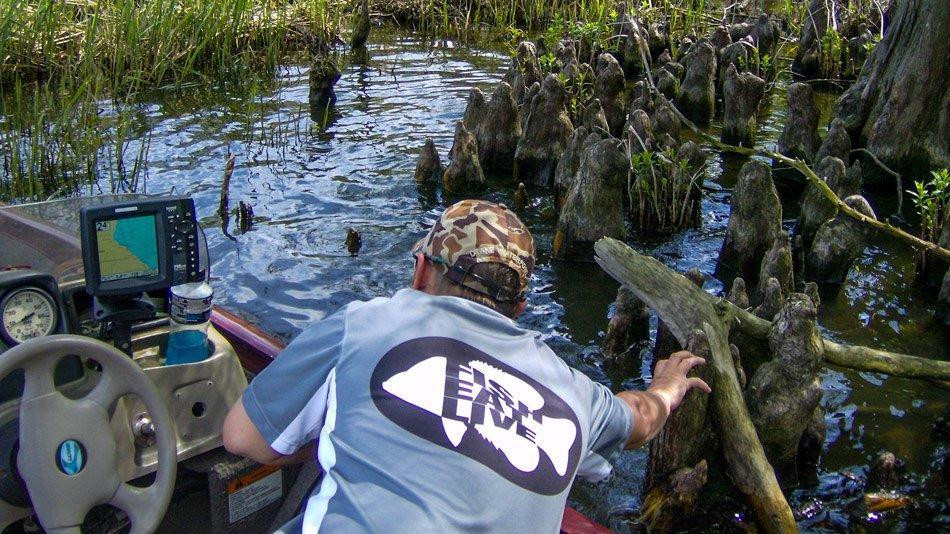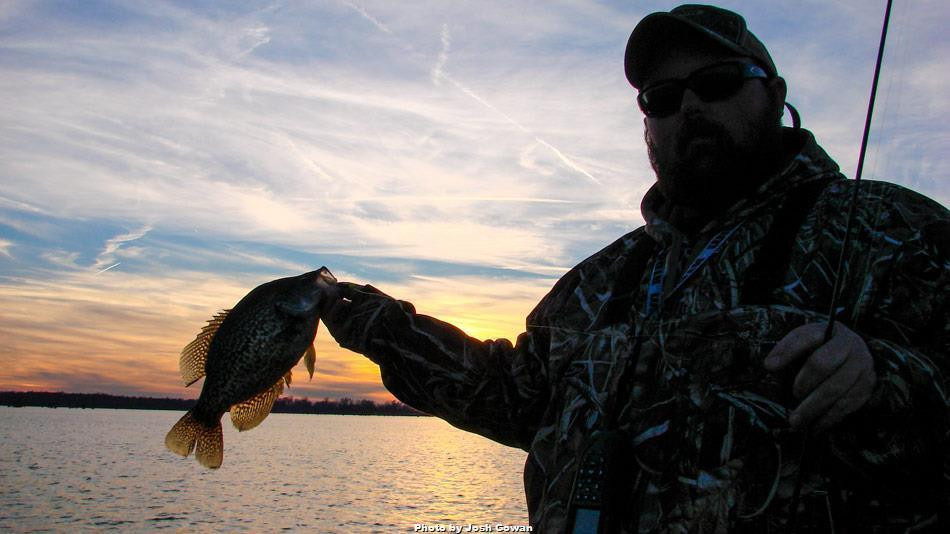Black crappie, or “specks”, act as a completely different species of fish on shallow water lakes, and targeting them is more comparable to bream fishing than traditional crappie fishing. Black crappie spawn earlier than white crappie, and often live their entire life in less than 5 feet of water on some lakes. Knowing the difference between the species and how they interact with their environment is key, and the first step to catching a mess of large, aggressive specks.
To become adept at catching black crappie around the spawn takes knowing and mastering the following 5 things:
- Crappie identification
- Picking the right bait
- Figuring out the pattern
- Gearing up
- Landing the fish
Know the difference
Knowing the difference between black and white crappie is simple, but it can be very important. If you’re just out fishing, and begin catching one or the other of the species, there are adjustments you can make to more aptly target those fish. Essentially they are different by looks in that the white crappie has vertical bars on its sides and a black crappie has random spots all over. But the real difference is in their diet and habitat.
The difference in body types and mouths is directly linked to their diet, as they have evolved to be more effective predators. White crappie’s large mouth assists them in eating large baitfish like minnows and shad, which make up the bulk of their diet, while black’s smaller, upward facing mouths is more useful in eating insects falling from the top of the water, which is their primary prey in shallow water lakes, along with crayfish and small minnows.
The bite is also different among the two species. The “THUMP” all one-rod fishermen live for is created by a crappie quickly opening its mouth pulling water through its gills, which is a much more violent process with the large mouths of white crappie. Black crappie are more likely to produce a “tick”, or nothing at all, as they generally don’t displace much water pulling in small bugs. Once the hook is set, however, black crappie out-fight white’s 10 to 1.
Black crappie prefer clearer water with heavy vegetation, and in some shallow water lakes, blacks will stay in depths of 5-foot or less year around. White crappie can tolerate much muddier water, and will suspend in deeper water.

Picking the right bait
Hand-tied jigs excel– When targeting shallow water black crappie, big plastics are generally not going to do the trick. These fish are preying on small bugs, and matching the hatch is key. Small, 1/16 to 1/80-ounce hand-tied jigs more closely resemble small insects than plastics, and the slow fall you get with the lighter jig will garner more bites. Popular hand-tied jigs include the Grizzly Jig and the Popeye Jig.
Color matters – Specks tucked in the shallows usually enjoy clear to lightly stained water, so utilizing natural color when choosing a bait is key. It is important to remember though, that insects on or in clear water, and especially under the rays of the sun, take on many colors. Black, brown, orange, and of course chartreuse are a few good places to start.
Scent helps – With black crappie barely opening their mouths and just picking up the bait, it’s important to have some form of scented attractant on your jig. Waxworms, Berkely Honey Worms or Crappie Nibbles all will work to not only make the crappie hold on longer, but will often result in a quick second bite putting the hook further back in the fish’s mouth.
Minnows to cover – Small minnows are also common prey for black crappie, and there is a time and place for them. When fishing a vast area of vegetation like lily pad stubble, it can often be tough to pinpoint crappie. A small, active minnow hung from a float and slowly worked through the stubble will sometimes trigger a crappie to come out after it, giving up the area where other fish may be hiding.

Figuring out the bite
Methodically lowering your bait around cover, be it wood, vegetation, or artificial, is key when jigging for black crappie. In shallow water, specks will often be just under the surface or holding just below cover that provides shade. Black crappie look for bugs falling from the surface, so emulating that slow fall will trigger more strikes.
Utilizing a slow fall will also help you pinpoint where the crappie are holding in the water column. Even in as shallow as 2 feet of water, there is generally a very specific depth where the fish will be, and fishing below that depth is often futile.
Horizontal jigging – Pitching small crappie jigs out and letting them “swim” back until your line is vertical will sometimes induce a bite that otherwise might not have happened. While shallow water and heavy cover limit the variety of presentations, there are still a few options, and horizontal movement should not be overlooked, especially around lily pads and standing timber.
When to speed up – There is a time to put the pedal to the floor, but not until you know the road ahead. Once you’ve pinpointed the pattern and know what kind of cover the crappie are holding on, how deep in the water column they are, and have proven that your bait is working, hammer the throttle and put it all to the test. The more precise of a pattern you figure out, the faster you can go from spot to spot picking off hungry black crappie. If the bite slows down, presentation should slow down with it.
Stay off the bottom – Crappie very rarely feed down, and black crappie do it even less, so keeping your jig at least 6-inches off the bottom and above will catch more fish.
Gearing up for the shallows
Vertical jigging in stained to clear water requires extreme stealth. The idea is to sneak up to a likely spot and lower your jig directly in front of the crappie, which may be no more than 6-inches deep. Without the right gear, this is impossible.
The right rod – The rod needed for shallow water jigging depends on the boat you’re fishing out of. If you’re in a 10-foot aluminum boat and a sculling paddle is the means of propulsion, you can get away with a 9-foot rod. As your boat and trolling motor size increase, so must the length of the rod. Any boat measuring 16 feet or longer and pushed by a 55-pound trolling motor or more, is best served with an 11 or 12-foot pole.
Graphite is a must, not only for the sensitivity, but for the weight as well. A fiberglass pole in the same length would weigh twice as much as a graphite rod, and holding it all day, gently lowering it and easing it through and around tree limbs, brush, and lily pads would wear out the strongest of arms fairly quick.
A bottom seated jig pole is also an advantage. With the reel on the very bottom of the rod, your reach is extended by 6-inches, and the farther you are away while still being able to fish vertically above the crappie will result in more bites.
The lightest and most popular 12-foot, bottom reel seated rod on the market is the B’n’M Buck’s Best Ultralight with bottom reel seat, weighing around 7-ounces. Other popular vertical jigging rods available in 10 to 12-foot are the Wally Marshall Solo, B’n’M Sam Heaton, Ozark, and Grizzly Elite.
No need to reel – Reels are a matter of preference in this style of fishing. More often than not, the hand that is not busy setting the hook is holding the line and assisting in landing the fish. Low profile and dependability are the primary features to look for in a shallow water jigging reel. A small baitcaster or fly reel is more than adequate for this tactic. The top three reels available are the Grizzly G-5000, Mr. Crappie Solo Reel, and the B’n’M Buck’s Ultralight Crappie Reel.
Terminal tackle – A 1/16 to 1/80-ounce feather or marabou jig tipped with a scented attractant is always a good starting point for jigging shallow water. Plastics will work as well, and for black crappie, staying small (1 to 1 1/2 inches) is more important than the type of jig. But tube and stinger jigs are the most common. Never use a splitshot above the jig, as this will not only hinder bite detection, but also make it nearly impossible to get freed from a snag.
Line – 6-pound monofilament is the most common line used for this tactic, and if there’s any stain at all to the water, hi-visibility line will be advantageous to both bite detection and for weaving your jig through and around cover without getting hung. Some anglers also use braided line for the added strength and sensitivity.
Power poles, push poles and rear trolling motors – Without stealth, the best gear on the market won’t do much good. Small boats are best for this type of fishing, not only for their ease of movement but their ability to fit in tighter places than larger boats. Using a sculling paddle, a push pole, or simply pulling yourself from limb to limb is the best way to move about in shallow water.

Prep your boat
Large boats can still get the job done, and have a few advantages of their own, like offering the ability to move around the boat and fish different areas without moving the entire vessel. Power Poles or Minn Kota Talons are great devices for holding a big boat in shallow water, but you’re going to have to move eventually. If you’re in open water with scattered cover, turn the trolling motor up and get a running start, but let off well before you get to the area you intend to fish.
When fishing standing timber or some other sturdy cover above the water’s surface, if you’re going to overrun your target or the wind pushes you into it, flip your jig pole around and use the butt of the rod to slow yourself down (this probably voids the warranty on the rod, so be careful!)
If vast areas of vegetation like moss or lily pads are the target, consider adding a small trolling motor to the transom of the boat. Even on a large boat, a 30-pound trolling motor in a fixed position on the back of the boat can push you closer to the fish without having to make any noise up front. A Big Foot Switch, which is a $20 switch designed to sit flat and be operated by pressing it with your foot, is easily wired between the battery and trolling motor and the switch is mounted on the front of the boat.
Getting them in the boat
Black crappie bite often bite light, and always fight hard, so getting them in the boat can sometimes be a challenge. The fact that you’re hanging 3-feet of line from the end of a 10 to 12-foot rod, often with branches above you and thick vegetation or brush below, certainly doesn’t make landing big specks any easier.
Own a net – Every crappie fisherman should have a long handled net in the boat, even if you rarely ever use it. This tactic is designed to fish in heavy cover for a hard fighting fish, and having a net on board may be the difference between a new personal best and a sad, sad story!
Watch the line – The majority of the time there will be no “THUMP” with black crappie, and when they are active a “tic” is all you’ll get. Line movement is sometimes the best indicator of a bite, either moving slightly to one side, a subtle line “twitch”, or going slack, so knowing the depth of the water you’re fishing is very important.
Setting the hook – The term “paper-mouths” can only be describing the sides of a crappie’s mouth, as anyone knows who has buried a hook into the top portion, it is extremely tough. With vertical jigging, when setting the hook the point of the hook will follow the line straight up, the jighead will pull through the crappie’s mouth first, sending the hook directly into the top its mouth.
Set the hook hard! There is no concern of tearing the top of a crappie’s mouth, the concern is if an extremely subtle bite occurs, and you pick up on it slightly, poking the fish’s mouth rather than piercing it, in which case the crappie will “run” and you’ll pull, turning the hook and releasing the fish without so much as a scale.
If you think you got a bite, or you might have just got bumped, or it felt like a twig, or it might just be a small bream nibbling, or ANYTHING other than NOTHING happens, set the hook hard! There are 10 times the number of crappie lost due to poor, light hooksets than there are yanking the hook out of the fish’s mouth. If you find yourself in thick trees such as a cypress grove and have limbs above your rod, keep your other hand on the line and be ready to yank back hard, as this is the only way to get a good hookset when you can’t raise your rod.













